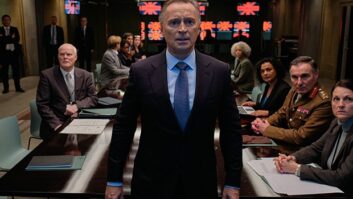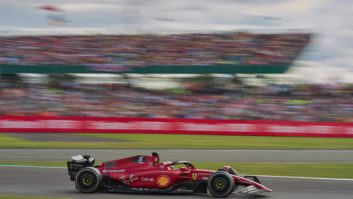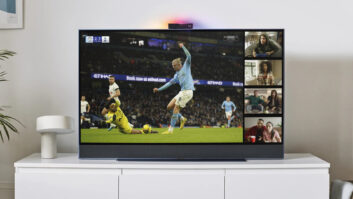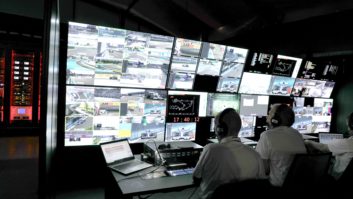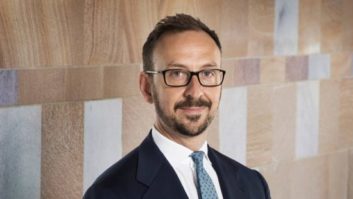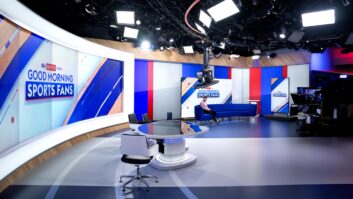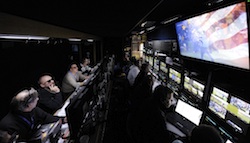
Last month’s dramatic Ryder Cup saw Sky Sports paired with Cameron-Pace Group (CPG) for the first time — and while the relationship is considered a resounding success, Sky has not bought into the pure 5D model.
While Europe clubbed the US to thrilling victory in the final round at the Medinah Country Club, the two titans of 3DTV – one a pioneer of technology, the other a pioneer in broadcast and production – were allying to deliver a 30-camera live 3D coverage.
For Sky and Cameron-Pace Group, the host production of the Ryder Cup in 3D was a chance to address a clash of 3D cultures head on and to find some common ground whereby both parties can work together in future.
“CPG’s goal is to achieve a 100% 5D production and I absolutely see the benefit of having 5D cameras, even in a majority of positions,” said Sky Director of Operations, Darren Long. “For us, it’s definitely a combination of 5D and additional, separate 3D cameras. 3D production is not a one size fit all.”
The broadcaster launched its 3D channel in 2010 from the Ryder Cup at Celtic Manor – in the rain – and the successor event represented their first major pairing with CPG and an opportunity for both parties to examine the philosophy of the other.
“When I first started looking at the Ryder Cup we considered taking full kit and crew over to the US and even our own trucks — but budgets always came in the way,” explained Long. “Working with CPG was, for both of us, a step into the unknown. We didn’t know each other very well and preparing everything over the phone and by email was as hard for them as it was for us.”
“We were a little nervous,” he admitted. “We’d seen some CPG output from the US Open golf and the US Masters where we thought certain things were good and certain things were not so good.
“The turning point was when Robin [Broomfield, Sky’s Ops and Development manager] and I met with Vince [Pace, co-chair of CPG] at IBC this year and we all got a sense of everyone pulling in the right direction. Vince heard from us a genuine understanding of what we wanted to deliver.
“He was concerned that we would just pitch up and demand to do it our way but he saw a passion in us, which is difficult to sense if you live and work on other sides of the world. We had a genuine one on one conversation and trust grew on both sides. We are intense and focused. We know what we want and we also had an absolute budget.”
Single Shadowcam
CPG was keen to work with the Shadowcam with the aim of adding more and more 5D onto the 2D infrastructure. “The problem for us was that while we had worked in a similar vein we are not experts at it and we like the whole idea of being able to control and have direction on the cameras,” explained Long.
In the event the alliance came too late in the day for the 3D production to upset the plans of the 2D host broadcast of NBC and European Tour Productions.
A single Shadowcam, on hole six, was deployed but enough to give Long an understanding of the Cameron Pace approach.
“The Shadowcam worked extremely well but I don’t know whether having one on every single camera means we lose a little control. We would not be able to direct those cameras, but only get what we are given. We wouldn’t, for example, be able to capture the colour at the climax on holes 17 and 18 without 3D cameras separate to the main production. In fact there were certain shots used on the 2D production that the 3D side got first.
“Yes, we understand that 5D saves money in certain areas but editorially we like to be in control and ensure we get what we need. For me the right approach is a combination of more 5D cameras plus independent ones as well.
“Before the Ryder Cup there was an us-and-them attitude but from day one, hole one we realised that everyone is pulling in the same direction and we were sorry to see the team broken up. Vince and I walked away with a real mindset change that we had built up this relationship.”
However, CPG won’t be reunited with Sky on any domestic UK productions any time soon. Long says he would jump at the chance to work with CPG on US or possibly European soil, the fact that Sky owns its own 3D trucks and equipment means the broadcaster needs to pay down the cost on those before hiring in the services of CPG on a more regular basis.
“I can’t wait to work with them again when the time arises but I can’t just throw away the kit we own,” he says.
3D entertainment
Thirty rigs were deployed on the course with convergence controlled in CPG’s Shadowcaster 15 facility. Vision mixing was performed in an adjacent truck from Dome Productions with key crew from Telegenic helping produce the 3D feed.
The armory included a super-slow motion 300fps camera on the first tee and three 3D wireless cams based on Sony TD300 units supplied by Presteigne Charter. The HD coverage fielded over 80 cameras to which Sky added another 20 cameras to augment its presentation.
Vince Pace said: “CPG is firmly rooted in a single production but we are having discussions with Sky on a creative and technical level. What we both share is a fundamental belief in the power of 3D as an entertainment medium and everyone is trying to determine the best way to get that value.”
He added: “For us, the Ryder Cup is … a significant step forward for 5D into the future with Sky. There’s a lot of new technology here but also a lot of people well seasoned in 3D production and that combination has not happened before. The Shadow system gives them a chance to see how it can be applied for future use on their side.”
Ideally, Pace said he would like to populate each hole with two 3D cameras – one to capture the putts and one for player reaction — but that wasn’t possible this time around given the number of positions already allocated to 2D cameras.
“We had a camera on every hole but that means for certain holes you are dependent on that single, critical camera,” said Pace. “We would like to be putting two cameras on every hole and to come out of the gate with an integrated 2D-3D package.”
Other CPG technology included the Camnet Profile Manager, which enabled one operator to control feeds from two 3D rigs. The technology is capable of controlling up to 20 cameras. Any movement in this direction will begin to reduce the number of additional crew required for the 3D operation.
By Adrian Pennington

